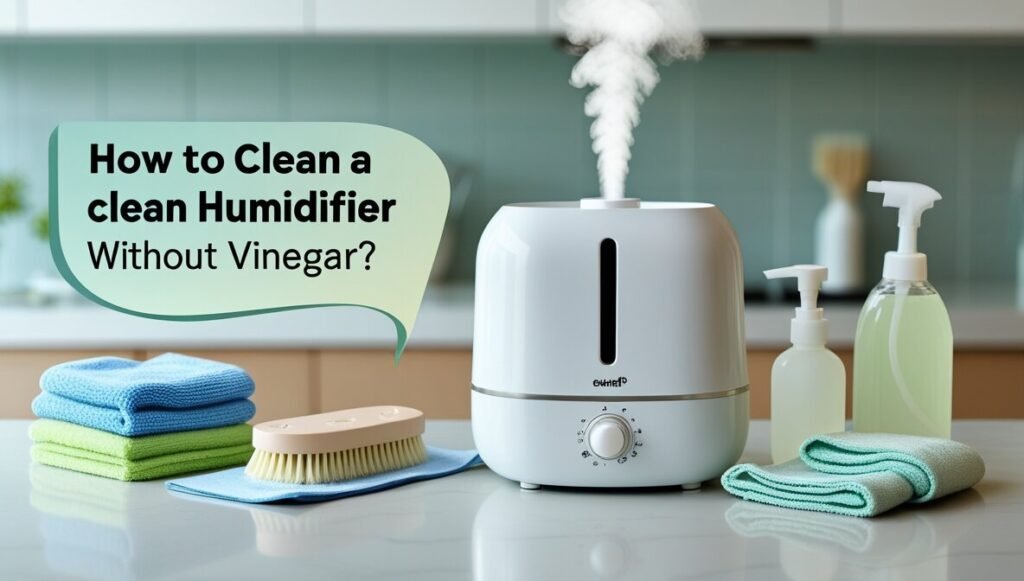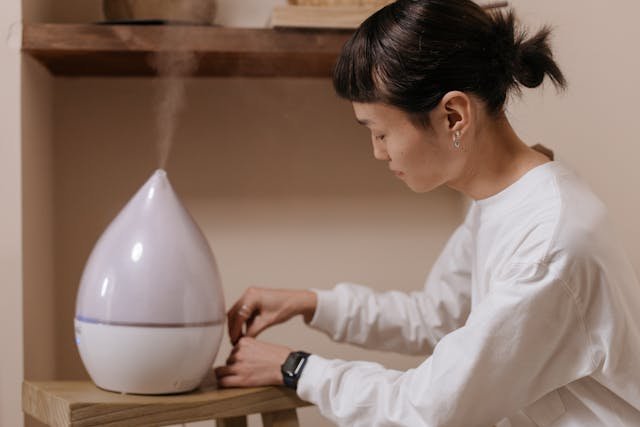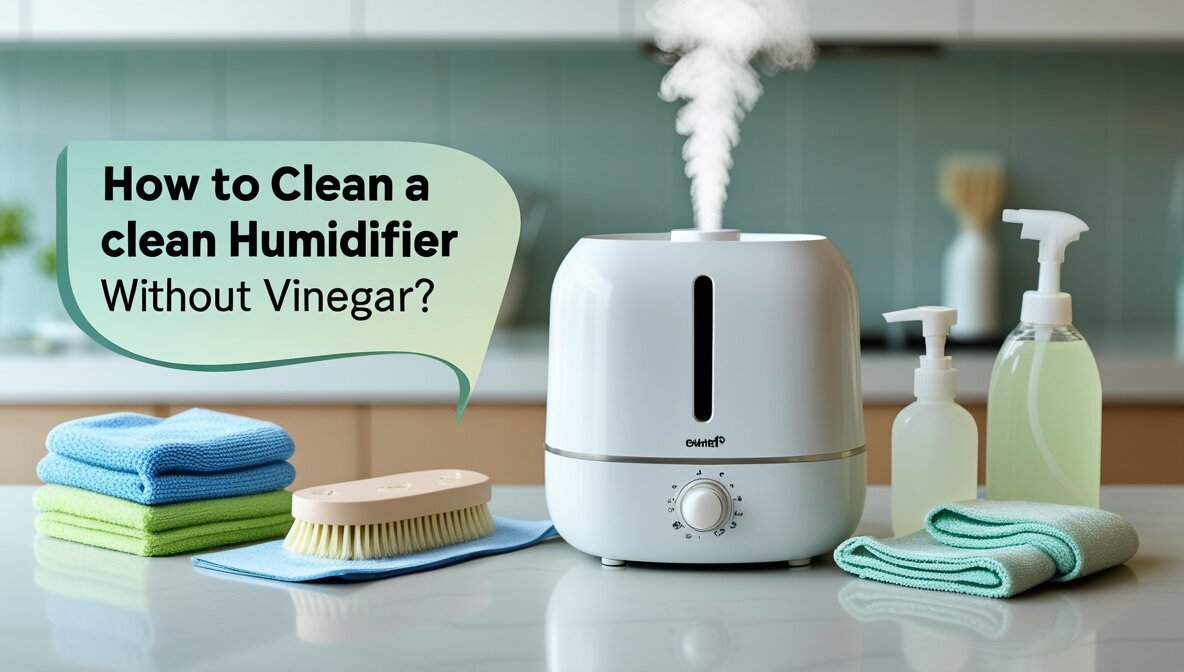Tired of the sharp, lingering smell of white vinegar after cleaning your humidifier? You’re not alone! Many people are looking for effective alternatives that get the job done without the pungent odor.
This guide will show you how to clean a humidifier without vinegar, using safe and efficient methods that are gentle on your device and your senses. These vinegar-free techniques, such as using hydrogen peroxide or other mild solutions, help remove buildup while being eco-friendly and ideal for delicate materials. Let’s explore how to keep your humidifier clean and running smoothly—without the smell of vinegar!

Why Avoid Vinegar for Humidifier Cleaning?
While vinegar is a popular cleaning agent, it’s not always the best choice for cleaning a humidifier. Here’s why:
1. Potential Damage to Humidifier Materials
The acidic nature of vinegar, especially undiluted white vinegar or a strong mix of white vinegar and water, can corrode or weaken certain parts of your humidifier. Rubber seals and plastic components inside the humidifier are particularly susceptible to damage, leading to leaks or reduced efficiency. Using alternative methods ensures the device stays intact and functions effectively.
2. Lingering Unpleasant Odor
Cleaning with vinegar often leaves a sharp, lingering smell. This can affect the air quality when you fill the tank and start the humidifier, creating an unpleasant experience in your living space. Switching to odor-free cleaning methods helps maintain a fresh and clean atmosphere.
3. Environmental Concerns
Frequent use of vinegar can have a minor environmental impact due to its production and disposal. While it’s biodegradable, excessive use in stagnant water or overcleaning with vinegar-based solutions can harm sensitive ecosystems. Opting for eco-friendly alternatives like hydrogen peroxide or mild scrubbing with clean water keeps your cleaning routine sustainable.
By avoiding vinegar, you can safely scrub away buildup, rinse thoroughly, and enjoy a fresh, long-lasting clean without compromising your humidifier or the environment.

How To Clean A Humidifier Without Vinegar?
Maintaining your humidifier doesn’t have to mean dealing with the sharp smell of vinegar. Here are four effective and natural ways to clean your humidifier without vinegar, ensuring it stays free of mold and bacteria while preserving your indoor air quality.
1. Baking Soda and Water Solution
Method:
- Mix 2 tablespoons of baking soda with warm water to create a gentle cleaning solution.
- Use a sponge or cloth dipped in the solution to scrub the water tank, base, and any other washable parts of your cool mist humidifier.
- For detachable components, such as the filter, remove and clean them separately if they are not disposable.
Tips:
- Always rinse thoroughly with clean water after cleaning to remove any baking soda residue.
- Avoid using baking soda in humidifiers with delicate parts to prevent abrasion.
2. Hydrogen Peroxide Solution
Method:
- Dilute hydrogen peroxide in a 1:1 ratio with water.
- Use the solution to clean the tank, base, and filter housing of your humidifier. Hydrogen peroxide is highly effective at killing mold and bacteria.
Tips:
- Wear gloves while cleaning to protect your skin.
- After cleaning, rinse all parts thoroughly and let them air dry before reassembling.
- Replace the filter every few months, as a clean filter improves performance and reduces buildup.
3. Commercial Humidifier Cleaners
Method:
- Choose a commercial humidifier cleaner designed for cleaning Vicks humidifiers or similar devices. These solutions are specifically formulated to combat mold and bacteria in humidifiers.
- Fill the water tank with the solution, allow it to soak as per the instructions, and then rinse thoroughly.
Tips:
- Opt for eco-friendly and non-toxic cleaners to protect both the environment and your device.
- Always read and follow the product instructions to avoid damage.
Caution:
- Avoid using harsh chemicals like chlorine bleach unless specified, as they can damage the humidifier’s parts and compromise air quality.
4. White Grapefruit Seed Extract
Method:
- Mix a few drops of white grapefruit seed extract with warm water to create a natural and safe cleaning solution.
- Use the mixture to wipe down the water tank and base, effectively removing mold and bacteria.
Tips:
- Dilute properly—typically 10–15 drops in a gallon of water.
- This method is ideal for sensitive materials and is eco-friendly.
Preventative Measures to Keep Your Humidifier Clean
Regular maintenance is key to ensuring your humidifier functions efficiently and maintains healthy indoor air quality. Here are some simple yet effective measures to prevent mineral buildup and ensure long-lasting performance.
1. Regular Cleaning
Frequent cleaning is the best way to prevent mineral buildup and mold in your humidifier.
- Why it’s important: Stagnant water in the tank can lead to mold, bacteria growth, and mineral deposits.
- How to clean: Wipe down the water tank, base, and detachable parts at least once a week using safe cleaning solutions, such as hydrogen peroxide or baking soda.
- Tip: Be sure to dry all parts thoroughly after cleaning to prevent moisture from lingering.
2. Using Distilled Water
Switching to distilled water instead of tap water is one of the easiest ways to reduce mineral buildup.
- Why it’s beneficial: Tap water often contains minerals that can accumulate inside the humidifier, clogging parts and releasing white dust into the air.
- How to use: Fill the tank with distilled or demineralized water every time you use the humidifier.
- Tip: Keep a jug of distilled water nearby to make the process convenient and hassle-free.
3. Proper Maintenance
Routine maintenance is essential for optimal performance and longevity.
- Replace filters: Change the filter regularly (as recommended by the manufacturer) to ensure the humidifier operates effectively and remains free of contaminants.
- Inspect for wear: Check the seals, tank, and other components for signs of wear or damage. Replace worn-out parts promptly to avoid leaks or inefficiency.
- Drain after use: Always empty the water tank after each use to prevent stagnant water from sitting inside.
Why These Steps Matter
By committing to regular cleaning, using distilled water, and performing proper maintenance, you can significantly reduce the chances of mineral buildup, mold, and bacteria in your humidifier. These simple practices not only enhance the performance of your device but also contribute to healthier air for you and your family.
Conclusion: Clean and Maintain Your Humidifier Safely
Choosing vinegar-free methods for cleaning your humidifier is both effective and safe for your device and indoor air quality. With solutions like baking soda, hydrogen peroxide, and eco-friendly commercial cleaners, you can easily keep your humidifier fresh and free from harmful buildup. These methods not only help you learn how to clean a humidifier without vinegar but also ensure a more pleasant experience without lingering odors.
Regular cleaning and maintenance are essential to prevent mold and bacteria, ensuring your humidifier runs efficiently and provides clean, healthy moisture. Select the method that works best for your humidifier type and commit to proper care to enjoy a long-lasting, trouble-free device.
Can I clean a humidifier without using vinegar?
Yes, you can! There are several effective alternatives to vinegar, such as baking soda, hydrogen peroxide, or commercial humidifier cleaners. These methods help clean and disinfect your humidifier while avoiding the strong vinegar smell.
What is the best alternative to vinegar for cleaning a humidifier?
Hydrogen peroxide is a popular choice due to its ability to kill mold and bacteria effectively. Baking soda is another great option for gentle scrubbing and deodorizing. You can also use grapefruit seed extract for a natural and eco-friendly cleaning solution.
How often should I clean my humidifier?
It’s recommended to clean your humidifier at least once a week to prevent mold, bacteria, and mineral buildup. For daily maintenance, empty and rinse the water tank to keep it fresh.
Can I use baking soda to clean my humidifier?
Yes, baking soda is a safe and effective option. Mix 2 tablespoons of baking soda with warm water, scrub the tank and base gently, and rinse thoroughly with clean water to remove any residue.
Is hydrogen peroxide safe to use in a humidifier?
Yes, hydrogen peroxide is safe and highly effective for disinfecting a humidifier. Use a diluted solution (1:1 ratio with water), clean the parts, and rinse thoroughly before reassembling.
Can I use commercial humidifier cleaners?
Yes, commercial humidifier cleaners are specifically designed to remove mold, bacteria, and mineral buildup. Be sure to choose eco-friendly, non-toxic options and follow the product instructions carefully.
What kind of water should I use to prevent buildup in my humidifier?
Using distilled or demineralized water is the best way to prevent mineral deposits and white dust in your humidifier. Avoid using tap water, as it often contains minerals that can cause buildup.
Do I need to replace the filter regularly?
Yes, replacing the filter is an essential part of humidifier maintenance. Check your manufacturer’s recommendations, but generally, filters should be replaced every 1–3 months to ensure optimal performance.
How can I prevent mold and bacteria from growing in my humidifier?
Regular cleaning and maintenance are crucial to preventing mold and bacteria. Empty and dry the water tank daily, clean the humidifier weekly, and use disinfecting solutions like hydrogen peroxide to keep it fresh and safe.
Are vinegar-free cleaning methods better for all humidifier types?
Yes, vinegar-free methods are safe and suitable for all humidifier types, including cool mist and ultrasonic models. They are especially beneficial for humidifiers with delicate parts, as they avoid the potential damage caused by vinegar’s acidity.

Anamika is a passionate writer for Eco365Store.com, specializing in topics that inspire a cleaner, greener world. With expertise in home cleaning, recycling, and eco-friendly solutions, she crafts engaging and informative articles that help readers adopt sustainable practices in their daily lives.

